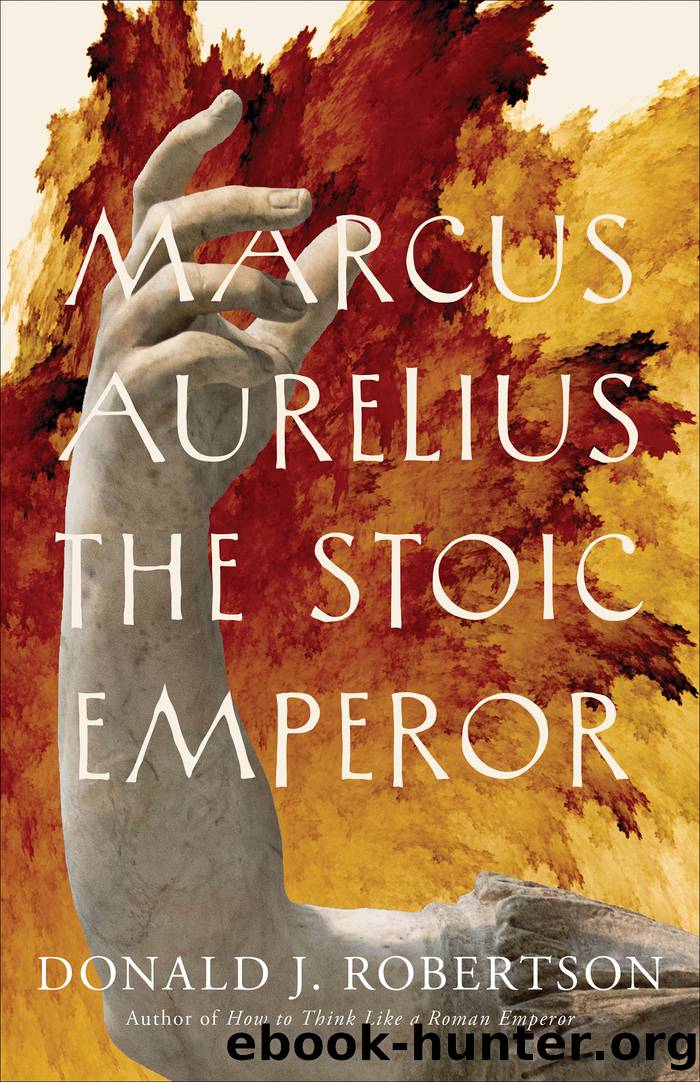Marcus Aurelius by Donald J. Robertson;

Author:Donald J. Robertson;
Language: eng
Format: epub
Publisher: Yale University Press
Published: 2024-02-15T00:00:00+00:00
CHAPTER TWELVE
The Antonine Plague
Every educated Roman knew how the Iliad, Homerâs epic about the Trojan War, began. As punishment for dishonoring one of his priests, Apollo exacted terrible revenge upon the Greek armies: âHe came down furious from the summits of Olympus, with his bow and his quiver upon his shoulder, and the arrows rattled on his back with the rage that trembled within him. He sat himself down away from the ships with a face as dark as night, and his silver bow rang death as he shot his arrow in the midst of them.â1 One soldier after another falls victim to a mysterious disease until bodies are burning all day long on pyres the length of the beach. Apollo, the god of healing, was also the god of plague.
Marcus Aurelius was just as powerless in the face of his own plague. The first outbreak affecting the city of Rome occurred in 166, shortly after the emperors had celebrated their triumph. On that day, the streets had swelled with roaring crowds who pressed forward to catch a glimpse of the shackled Parthians. Romeâs supremacy was confirmed, its people were jubilant, and its emperors blessed. The moment, however, would be all too brief.
Soon an invisible army would march across the whole empire, laying siege to every town and city. Suddenly people everywhere were being struck down by a terrifying disease, as if the god Apollo meant to punish the emperorsâbut for what transgression? Enemies on Romeâs borders were ready to pounce. Achilles had complained in the Iliad that the Greeks camped on the beaches of Troy were âbeing cut down by war and pestilence at once.â2 Marcus now faced the same double threat.
Many physicians were among the first to die, after being exposed to the infected patients in their care. Marcus would later contemplate this irony: âThink continually how many physicians are dead after often contracting their eyebrows over the sick.â3 Galen, one of the most celebrated physicians of antiquity, was in Rome to witness the initial outbreak. He was so alarmed that he immediately fled to the relative safety of Pergamum, his home city, in Asia Minor. As Galen was one of the fortunate ones, though, who turned out to be immune, he was able to study its victims closely. He became the empireâs leading authority on what was sometimes even called âGalenâs Plagueâ by later authors. Today, though, it is commonly known as the âAntonine Plagueâ after Marcusâs imperial dynasty, the Antonines.
Although retrospective diagnosis is very uncertain, the most widely accepted modern hypothesis is that the Antonine Plague was caused by a variant of the smallpox virus. It spread wherever large numbers of people lived in close proximity. The major cities and legionary camps of the empire were the worst affected. Outbreaks seem to have occurred intermittently until Marcusâs death, and perhaps for many years afterward, with mortality rates surging over the winter months.
Vomiting and malodorous breath were common symptomsâvictims could be said to literally reek of the plague.
Download
This site does not store any files on its server. We only index and link to content provided by other sites. Please contact the content providers to delete copyright contents if any and email us, we'll remove relevant links or contents immediately.
Hit Refresh by Satya Nadella(8344)
When Breath Becomes Air by Paul Kalanithi(7273)
The Girl Without a Voice by Casey Watson(7271)
Do No Harm Stories of Life, Death and Brain Surgery by Henry Marsh(6342)
A Court of Wings and Ruin by Sarah J. Maas(6110)
Hunger by Roxane Gay(4232)
Shoe Dog by Phil Knight(4181)
Everything Happens for a Reason by Kate Bowler(4075)
A Higher Loyalty: Truth, Lies, and Leadership by James Comey(4039)
The Rules Do Not Apply by Ariel Levy(3913)
Tuesdays with Morrie by Mitch Albom(3839)
The Immortal Life of Henrietta Lacks by Rebecca Skloot(3833)
How to Change Your Mind by Michael Pollan(3686)
Millionaire: The Philanderer, Gambler, and Duelist Who Invented Modern Finance by Janet Gleeson(3575)
All Creatures Great and Small by James Herriot(3526)
Elon Musk by Ashlee Vance(3460)
Tokyo Vice: An American Reporter on the Police Beat in Japan by Jake Adelstein(3441)
Man and His Symbols by Carl Gustav Jung(3325)
The Money Culture by Michael Lewis(3291)
